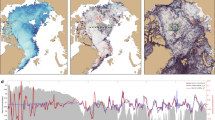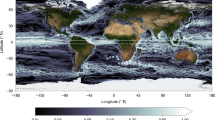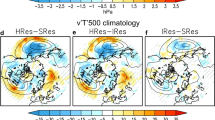Abstract
Current climate models systematically underestimate the strength of oceanic fronts associated with strong western boundary currents, such as the Kuroshio and Gulf Stream Extensions, and have difficulty simulating their positions at the mid-latitude ocean’s western boundaries1. Even with an enhanced grid resolution to resolve ocean mesoscale eddies—energetic circulations with horizontal scales of about a hundred kilometres that strongly interact with the fronts and currents—the bias problem can still persist2; to improve climate models we need a better understanding of the dynamics governing these oceanic frontal regimes. Yet prevailing theories about the western boundary fronts are based on ocean internal dynamics without taking into consideration the intense air–sea feedbacks in these oceanic frontal regions. Here, by focusing on the Kuroshio Extension Jet east of Japan as the direct continuation of the Kuroshio, we show that feedback between ocean mesoscale eddies and the atmosphere (OME-A) is fundamental to the dynamics and control of these energetic currents. Suppressing OME-A feedback in eddy-resolving coupled climate model simulations results in a 20–40 per cent weakening in the Kuroshio Extension Jet. This is because OME-A feedback dominates eddy potential energy destruction, which dissipates more than 70 per cent of the eddy potential energy extracted from the Kuroshio Extension Jet. The absence of OME-A feedback inevitably leads to a reduction in eddy potential energy production in order to balance the energy budget, which results in a weakened mean current. The finding has important implications for improving climate models’ representation of major oceanic fronts, which are essential components in the simulation and prediction of extratropical storms and other extreme events3,4,5,6, as well as in the projection of the effect on these events of climate change.
This is a preview of subscription content, access via your institution
Access options
Subscribe to this journal
Receive 51 print issues and online access
$199.00 per year
only $3.90 per issue
Buy this article
- Purchase on Springer Link
- Instant access to full article PDF
Prices may be subject to local taxes which are calculated during checkout




Similar content being viewed by others
References
Kwon, Y.-O. et al. Role of the Gulf Stream and Kuroshio–Oyashio systems in large-scale atmosphere–ocean interaction: a review. J. Clim. 23, 3249–3281 (2010)
Small, R. J. et al. A new synoptic scale resolving global climate simulation using the Community Earth System Model. J. Adv. Model. Earth Syst. 6, 1065–1094 (2014)
Nakamura, H., Sampe, T., Tanimoto, Y. & Shimpo, A. Observed associations among storm tracks, jet streams and midlatitude oceanic fronts. Geophys. Monogr. Ser. 147, 329–345 (2004)
Joyce, T. M., Kwon, Y.-O. & Yu, L. On the relationship between synoptic wintertime atmospheric variability and path shifts in the Gulf Stream and the Kuroshio Extension. J. Clim. 22, 3177–3192 (2009)
Frankignoul, C., Sennechael, N., Kwon, Y. O. & Alexander, M. A. Influence of the meridional shifts of the Kuroshio and the Oyashio Extensions on the atmospheric circulation. J. Clim. 24, 762–777 (2011)
Ma, X. et al. Distant influence of Kuroshio eddies on North Pacific weather patterns? Sci. Rep. 5, 17785 (2015)
Chelton, D. B., Schlax, M. G., Freilich, M. H. & Milliff, R. F. Satellite measurements reveal persistent small-scale features in ocean winds. Science 303, 978–983 (2004)
Xie, S.-P. Satellite observations of cool ocean–atmosphere interaction. Bull. Am. Meteorol. Soc. 85, 195–208 (2004)
Bryan, F. O. et al. Frontal scale air–sea interaction in high-resolution coupled climate models. J. Clim. 23, 6277–6291 (2010)
Small, R. J. et al. Air–sea interaction over ocean fronts and eddies. Dyn. Atmos. Oceans 45, 274–319 (2008)
Putrasahan, D. A., Miller, A. J. & Seo, H. Isolating mesoscale coupled ocean–atmosphere interactions in the Kuroshio Extension region. Dyn. Atmos. Oceans 63, 60–78 (2013)
Small, R. J., Tomas, R. A. & Bryan, F. O. Storm track response to ocean fronts in a global high-resolution climate model. Clim. Dyn. 43, 805–828 (2014)
O’Reilly, C. H. & Czaja, A. The response of the Pacific storm track and atmospheric circulation to Kuroshio Extension variability. Q. J. R. Meteorol. Soc. 141, 52–66 (2015)
Zhou, G. D., Latif, M., Greatbatch, R. J. & Park, W. Atmospheric response to the North Pacific enabled by daily sea surface temperature variability. Geophys. Res. Lett. 42, 7732–7739 (2015)
Qiu, B. & Chen, S. M. Eddy-mean flow interaction in the decadally modulating Kuroshio Extension system. Deep Sea Res. Part II 57, 1098–1110 (2010)
Waterman, S., Hogg, N. G. & Jayne, S. R. Eddy-mean flow interaction in the Kuroshio Extension region. J. Phys. Oceanogr. 41, 1182–1208 (2011)
Zhang, Z. G., Wang, W. & Qiu, B. Oceanic mass transport by mesoscale eddies. Science 345, 322–324 (2014)
Zhai, X. M. & Greatbatch, R. J. Surface eddy diffusivity for heat in a model of the northwest Atlantic Ocean. Geophys. Res. Lett. 33, L24611 (2006)
Qiu, B. & Chen, S. Variability of the Kuroshio Extension jet, recirculation gyre, and mesoscale eddies on decadal time scales. J. Phys. Oceanogr. 35, 2090–2103 (2005)
Minobe, S., Kuwano-Yoshida, A., Komori, N., Xie, S. P. & Small, R. J. Influence of the Gulf Stream on the troposphere. Nature 452, 206–209 (2008)
Kelly, K. A. et al. Western boundary currents and frontal air–sea interaction: Gulf Stream and Kuroshio Extension. J. Clim. 23, 5644–5667 (2010)
Frenger, I., Gruber, N., Knutti, R. & Munnich, M. Imprint of Southern Ocean eddies on winds, clouds and rainfall. Nat. Geosci. 6, 608–612 (2013)
Wu, L. X. et al. Enhanced warming over the global subtropical western boundary currents. Nat. Clim. Chang. 2, 161–166 (2012)
Gent, P. R., Yeager, S. G., Neale, R. B., Levis, S. & Bailey, D. A. Improvements in a half degree atmosphere/land version of the CCSM. Clim. Dyn. 34, 819–833 (2010)
McClean, J. L. et al. A prototype two-decade fully-coupled fine-resolution CCSM simulation. Ocean Model. 39, 10–30 (2011)
Delworth, T. L. et al. Simulated climate and climate change in the GFDL CM2.5 high-resolution coupled climate model. J. Clim. 25, 2755–2781 (2012)
Kirtman, B. P. et al. Impact of ocean model resolution on CCSM climate simulations. Clim. Dyn. 39, 1303–1328 (2012)
Wang, C. Z., Zhang, L. P., Lee, S. K., Wu, L. X. & Mechoso, C. R. A global perspective on CMIP5 climate model biases. Nat. Clim. Chang. 4, 201–205 (2014)
Drews, A., Greatbatch, R. J., Ding, H., Latif, M. & Park, W. The use of a flow field correction technique for alleviating the North Atlantic cold bias with application to the Kiel Climate Model. Ocean Dyn. 65, 1079–1093 (2015)
Griffies, S. M. et al. Impacts on ocean heat from transient mesoscale eddies in a hierarchy of climate models. J. Clim. 28, 952–977 (2015)
Large, W. G. & Yeager, S. G. The global climatology of an interannually varying air-sea flux data set. Clim. Dyn. 33, 341–364 (2009)
Bishop, S. P., Bryan, F. O. & Small, R. J. Bjerknes-like compensation in the wintertime North Pacific. J. Phys. Oceanogr. 45, 1339–1355 (2015)
Skamarock,W. C. et al. A Description of the Advanced Research WRF Version 3. NCAR Technical Note NCAR/TN-475+STR, http://dx.doi.org/10.5065/D68S4MVH (National Center for Atmospheric Research, 2008)
Large, W. G., Mcwilliams, J. C. & Doney, S. C. Oceanic vertical mixing—a review and a model with a nonlocal boundary-layer parameterization. Rev. Geophys. 32, 363–403 (1994)
Griffies, S. M. & Hallberg, R. W. Biharmonic friction with a Smagorinsky-like viscosity for use in large-scale eddy-permitting ocean models. Mon. Weath. Rev. 128, 2935–2946 (2000)
Carton, J. A. & Giese, B. S. A reanalysis of ocean climate using Simple Ocean Data Assimilation (SODA). Mon. Weath. Rev. 136, 2999–3017 (2008)
Kanamitsu, M. et al. NCEP-DOE AMIP-II reanalysis (R-2). Bull. Am. Meteorol. Soc. 83, 1631–1643 (2002)
Schlax, M. G. & Chelton, D. B. Frequency-domain diagnostics for linear smoothers. J. Am. Stat. Assoc. 87, 1070–1081 (1992)
von Storch, J. S. et al. An estimate of the Lorenz energy cycle for the world ocean based on the 1/10 degrees STORM/NCEP simulation. J. Phys. Oceanogr. 42, 2185–2205 (2012)
Marshall, J. & Shutts, G. A note on rotational and divergent eddy fluxes. J. Phys. Oceanogr. 11, 1677–1680 (1981)
Eden, C., Greatbatch, R. J. & Olbers, D. Interpreting eddy fluxes. J. Phys. Oceanogr. 37, 1282–1296 (2007)
Ducet, N., Le Traon, P. Y. & Reverdin, G. Global high-resolution mapping of ocean circulation from TOPEX/Poseidon and ERS-1 and -2. J. Geophys. Res. 105, 19477 (2000)
Kurian, J., Colas, F., Capet, X., McWilliams, J. C. & Chelton, D. B. Eddy properties in the California Current System. J. Geophys. Res. 116, C08027 (2011)
Waliser, D. E. et al. The “year” of tropical convection (May 2008-April 2010) climate variability and weather highlights. Bull. Am. Meteorol. Soc. 93, 1189–1218 (2012)
Saha, S. et al. The NCEP climate forecast system reanalysis. Bull. Am. Meteorol. Soc. 91, 1015–1057 (2010)
Acknowledgements
This research is a collaboration between TAMU and OUC led by P.C. at TAMU, and is supported by US National Science Foundation grants AGS-1462127 and AGS-1067937, and National Oceanic and Atmospheric Administration grant NA11OAR4310154, as well as by China’s National Basic Research Priorities Programme (2013CB956204 and 2014CB745000) and the Natural Science Foundation of China (41490644 and U1406401). P.C. was partially supported by the Excellence Cluster, Future Ocean, Kiel and the SFB754 and by the 2015 Francis Bretherton Visitorship during his sabbatical leave at GEOMAR and NCAR, respectively. The Texas Advanced Computing Center at The University of Texas at Austin and the Texas A&M High Performance Research Computing provided the computing resources we needed to perform our CRCM simulations.
Author information
Authors and Affiliations
Contributions
X.M. conducted the CRCM simulations and performed most of the analyses. Z.J. carried out the eddy energetic analysis. P.C. (lead investigator) conceived the project and wrote the manuscript. X.L. assisted with data analyses. R.M. developed CRCM and its parallel Loess filter and provided assistance during model setup and use. R.J.S. and F.O.B. performed the global CESM simulations. R.J.G. and P.B. were involved in interpreting the results. D.W, X.L. and L.W. participated in the design of the study. All authors contributed to improving the manuscript.
Corresponding author
Ethics declarations
Competing interests
The authors declare no competing financial interests.
Additional information
Reviewer Information
Nature thanks K. Kelly and M. Petersen for their contribution to the peer review of this work.
Extended data figures and tables
Extended Data Figure 1 Long-term mean Kuroshio response to OME-A feedback simulated by CESM.
Composite of winter-season (ONDJFM) mean U velocity (colour scale and contours in metres per second) zonally averaged between 145° E and 160° E for the whole of the 11-year CESM simulations in CTRL (a), MEFS (b) and MEFS minus CTRL (c). The composite was taken according to the axis of the winter mean KEJ defined by the latitude of maximum U velocity. The x axis is the distance from the KEJ axis.
Extended Data Figure 2 Large-scale wind stress and curl change simulated by CESM.
Annual mean large-scale wind stresses (vectors) and wind stress curl (colour scale) in CTRL (a) and MEFS minus CTRL (b) averaged over the 11-year CESM simulations. The large-scale wind stresses are obtained using a 10° (longitude) × 10° (latitude) boxcar filter. The wind stress curl differences, significant with P value less than 0.05, based on monthly mean data using a Student’s t-test are marked by red crosses in b.
Extended Data Figure 3 EPE budget in the Kuroshio Extension region.
a, Vertical profile of winter season (ONDJFM) mean EPE budget averaged over 145° E–160° E, 30° N–42° N for the CRCM CTRL ensemble (solid) and CRCM MEFS ensemble (dashed). b, As for a, except for MEFS minus CTRL. The inset tables summarize the vertically integrated EPE budget in the upper 250 m for CTRL and MEFS in a and for MEFS minus CTRL in b. Each of the EPE budget terms is indicated using a different colour, and solid and dashed lines in a represent CTRL and MEFS, respectively.
Extended Data Figure 4 Temperature gradient response in the Kuroshio Extension region simulated by CESM and CRCM.
a–c, Composite of winter-season mean meridional temperature gradient (colour scale and contours in degrees Celsius per degree latitude) averaged between 145° E and 160° E across the Kuroshio Extension Front in CTRL (a), MEFS (b) and MEFS minus CTRL (c) based on 11-year CESM simulations. The x axis is the distance from the KEJ axis at 0 defined by the latitude of winter mean maximum U and the y axis is depth. d–f, As for a–c, but for the CRCM twin ensembles.
Extended Data Figure 5 Mean flow and eddy response to OME-A feedback in the Gulf Stream simulated by CESM.
a–c, Composite of winter season mean U velocity (colour scale and contours in metres per second) along 60° W based on 11-year CESM simulations. The composite was taken according to the axis of the winter mean Gulf Stream current along 60° W defined by the latitude of maximum U velocity. The x axis is the distance from the Gulf Stream current. d, Ratio of EKE spectra between MEFS and CTRL in the Gulf Stream Extension region (35° N–42° N, 70° W–55° W) based on 11-year CESM simulations. e, As for d, but for eddy enstrophy (ENS) spectra. The grey shading indicates the geometric standard deviation of EKE and enstrophy ratio in individual years of the CESM simulations (d and e).
Rights and permissions
About this article
Cite this article
Ma, X., Jing, Z., Chang, P. et al. Western boundary currents regulated by interaction between ocean eddies and the atmosphere. Nature 535, 533–537 (2016). https://doi.org/10.1038/nature18640
Received:
Accepted:
Published:
Issue Date:
DOI: https://doi.org/10.1038/nature18640
This article is cited by
-
Exceptional multi-year prediction skill of the Kuroshio Extension in the CESM high-resolution decadal prediction system
npj Climate and Atmospheric Science (2023)
-
Vertical structures of marine heatwaves
Nature Communications (2023)
-
Reduced Southern Ocean warming enhances global skill and signal-to-noise in an eddy-resolving decadal prediction system
npj Climate and Atmospheric Science (2023)
-
Oceanic mesoscale eddies as crucial drivers of global marine heatwaves
Nature Communications (2023)
-
The benefits of high-resolution models in simulating the Kuroshio Extension and its long-term changes
Climate Dynamics (2023)
Comments
By submitting a comment you agree to abide by our Terms and Community Guidelines. If you find something abusive or that does not comply with our terms or guidelines please flag it as inappropriate.



